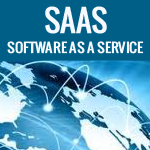SaaS or Software as a Service
You cannot open your email, read a technology magazine, or 
hit an IT industry-related site without reading something about
the cloud and Software as a Service (SaaS.)
Cloud computing, and SaaS in particular, represent a fundamental
shift in how business computing is delivered, and it’s essential for the
IT admin in a small to mid-sized business to understand that the cloud is
not the exclusive playground of the enterprise.
SaaS is built to Scale
SaaS and other core services are built to scale, from the smallest sole proprietorship
to the largest mega corp., and anyone can take advantage of the benefits offered by the cloud.
Let’s take a look at how cloud-based IT management and SaaS can help
IT admins manage their company’s systems more effectively.
Cost effective solutions
SaaS systems tend to be built around a subscription model, enabling customers to buy just what they need, and to scale up as business needs dictate. With a SaaS solution, an IT admin can start utilizing the software as a pilot, and then quickly and easily add more devices as they are needed. IT admins don’t have to buy hardware or software licenses. They just subscribe to what they need. Without that upfront investment, many IT admins find they can classify the costs of these subscriptions as operational expenses, which can be very beneficial to the bottom line.
Expand Core software services
The smaller the IT department, the less it can offer when using traditional solutions. There’s only a limited number of hours in the day, and you don’t have half as many people as you probably want right now. SaaS solutions empower IT to utilize software that might otherwise not have been within their reach. SaaS solutions can also enable you to use the latest versions of existing services, like email or telephony, security assessments, CRM, and more.
Easy deployment
The beauty of SaaS solutions is that the vendor has done all the hard work for you, and has gone to great lengths to make it as easy as possible to start using their software. Cloud-based IT management software can be deployed as easily as signing up, deploying an agent, and starting to use the software. Other SaaS offerings may need nothing more than a web browser. And all of them tend to offer free trials, so you can try before you buy. What could be easier than that?
Flexibility
SaaS is not an all or nothing proposition. Consider the cloud an all you can eat buffet. You can pick and choose what you want to move to a SaaS solution, and which core business applications it makes sense to manage and run in-house. Moving some systems to a cloud-based IT management solution can save time and effort; E.g. If you migrate to a cloud-based email system, you can still manage all the aspects of users and mail, but the SaaS provider will take care of backups and restores, capacity planning, patching and maintenance, so you don’t have to schedule someone to stay up all night Saturday applying a service pack.
Security
SaaS is not a fad; it’s a sea change in technology the likes of which we haven’t seen since moving from mainframes to PCs. Vendors know that their customers place a great deal of trust in them, so security is a very serious business to them. When you consider a SaaS provider, ask them for their take on security. The good ones will be able to show you the numerous independent audits they have passed and security certifications they have earned, so you know your data is well protected. Most organizations, from small to mid-sized businesses to the enterprise, tend to find SaaS providers have better security in their cloud offerings than they could provide themselves.
Availability
Do you offer a Service Level Agreement (SLA) to your internal users? Are you rated on it? How’s that working out for you? SaaS offerings come with SLAs and commit to you as their customer that services will be available. Cloud-based IT management systems can even help you with your own SLAs, by monitoring and alerting on the core systems you decide to keep in-house. When a monitoring system alerts you to a problem before it becomes an outage, you can react before you take an SLA hit, and your users (and managers) will see the difference.
Where do you start?
Consider how you handle antivirus updates. You may let each machine update itself, and hope that it works. What about patching? Do you turn on automatic updates and cross your fingers that an untested patch doesn’t conflict with a critical legacy app? Is your first indication of a problem when a user calls asking if something is down? Are you keeping inventory in an Excel spreadsheet that hasn’t been updated in months? And how many different remote access solutions do you have deployed across servers and workstations. A cloud-based IT management solution can provide IT admins with solutions to all of these problems, without requiring them to build more servers, install more applications, or budget for another big investment. It’s a great place to start, since it will provide immediate benefit to your IT environment, your users and the bottom line. Once you get comfortable with cloud-based IT management, you can start to sample the other SaaS products available to you.
When it comes to planning for the future, and adopting industry trends, SaaS solutions are the cost effective and extremely beneficial technologies that forward-thinking IT admins want to adopt. Cloud-based IT management solutions are the perfect place to start. If you’ve been looking ahead to see what the next big thing is, now you know.
This guest post was provided on behalf of GFI Cloud.
Find out more about their Cloud-based IT Management and SAAS solutions.
